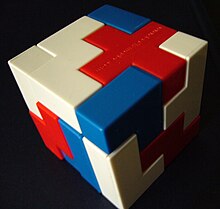
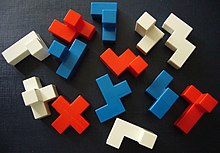

The Bedlam cube is a solid dissection puzzle invented by British puzzle expert Bruce Bedlam. [1] [2]



The Bedlam cube is a solid dissection puzzle invented by British puzzle expert Bruce Bedlam. [1] [2]
The puzzle consists of thirteen polycubic pieces: twelve pentacubes and one tetracube. The objective is to assemble these pieces into a 4 x 4 x 4 cube. There are 19,186 distinct ways of doing so, up to rotations and reflections.
The Bedlam cube is one unit per side larger than the 3 x 3 x 3 Soma cube, and is much more difficult to solve.
Two of the BBC's 'Dragons' from Dragons' Den , Rachel Elnaugh and Theo Paphitis, were to invest in the Bedlam cube during the 2005 series. They offered £100,000 for a 30% share of equity in Bedlam Puzzles. Danny Bamping (the entrepreneur behind Bedlam cube) finally chose a bank loan instead of their investment, as seen in the relevant "Where Are They Now" episode of Dragons' Den. [3]
According to Guinness World Records , the official world record for assembling the Bedlam Cube is 11.03 seconds by Danny Bamping on 9 November 2006. [4] The blindfolded record is 27.21 seconds by Aleksandr Iljasov on 25 February 2008. [5]

The Rubik's Cube is a 3-D combination puzzle originally invented in 1974 by Hungarian sculptor and professor of architecture Ernő Rubik. Originally called the Magic Cube, the puzzle was licensed by Rubik to be sold by Pentangle Puzzles in the UK in 1978, and then by Ideal Toy Corp in 1980 via businessman Tibor Laczi and Seven Towns founder Tom Kremer. The cube was released internationally in 1980 and became one of the most recognized icons in popular culture. It won the 1980 German Game of the Year special award for Best Puzzle. As of March 2021, over 450 million cubes had been sold worldwide, making it the world's bestselling puzzle game and bestselling toy. The Rubik's Cube was inducted into the US National Toy Hall of Fame in 2014.
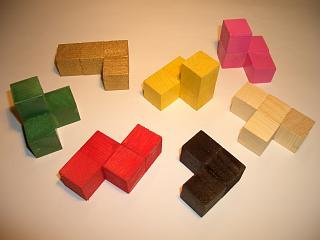
The Soma cube is a solid dissection puzzle invented by Danish polymath Piet Hein in 1933 during a lecture on quantum mechanics conducted by Werner Heisenberg.

A jigsaw puzzle is a tiling puzzle that requires the assembly of often irregularly shaped interlocking and mosaicked pieces, each of which typically has a portion of a picture. When assembled, the puzzle pieces produce a complete picture.

The Rubik's Revenge is a 4×4×4 version of the Rubik's Cube. It was released in 1981. Invented by Péter Sebestény, the cube was nearly called the Sebestény Cube until a somewhat last-minute decision changed the puzzle's name to attract fans of the original Rubik's Cube. Unlike the original puzzle, it has no fixed faces: the center faces are free to move to different positions.
Mathematical puzzles make up an integral part of recreational mathematics. They have specific rules, but they do not usually involve competition between two or more players. Instead, to solve such a puzzle, the solver must find a solution that satisfies the given conditions. Mathematical puzzles require mathematics to solve them. Logic puzzles are a common type of mathematical puzzle.
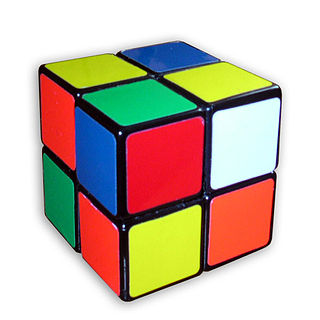
The Pocket Cube' is a 2×2×2 version of the Rubik's Cube. The cube consists of 8 pieces, all corners.
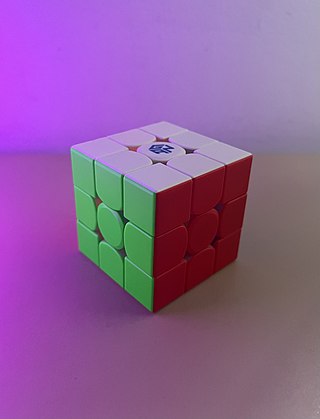
Speedcubing is a competitive sport that involves solving a variety of combination puzzles, the most well-known of which is the 3x3x3 puzzle, as quickly as possible. A person who competitively solves combination puzzles is called a speedcuber, or a cuber. To solve most puzzles, the contestant has to perform a series of moves, called algorithms, that transform a scrambled puzzle into a solved state.

The Professor's Cube is a 5×5×5 version of the original Rubik's Cube. It has qualities in common with both the 3×3×3 Rubik's Cube and the 4×4×4 Rubik's Revenge, and solution strategies for both can be applied.
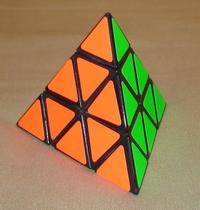
The Pyraminx is a regular tetrahedron puzzle in the style of Rubik's Cube. It was made and patented by Uwe Mèffert after the original 3 layered Rubik's Cube by Ernő Rubik, and introduced by Tomy Toys of Japan in 1981.

Rubik's Clock is a mechanical puzzle invented and patented by Christopher C. Wiggs and Christopher J. Taylor. The Hungarian sculptor and professor of architecture Ernő Rubik bought the patent from them to market the product under his name. It was first marketed in 1988.

The Square-1 is a variant of the Rubik's Cube. Its distinguishing feature among the numerous Rubik's Cube variants is that it can change shape as it is twisted, due to the way it is cut, thus adding an extra level of challenge and difficulty. The Super Square One and Square Two puzzles have also been introduced. The Super Square One has two additional layers that can be scrambled and solved independently of the rest of the puzzle, and the Square Two has extra cuts made to the top and bottom layer, making the edge and corner wedges the same size.
Leyan Andrew Lo held the world record of 11.13 seconds for the fastest Rubik's Cube solve until Toby Mao in 2006 had a solve of 10.48 at the U.S. nationals competition in San Francisco. Leyan appeared on The Tonight Show with Jay Leno, where he solved a Rubik's Cube in 18.9 seconds. He also holds the former world record for the fastest blindfolded Rubik's Cube solve, at 1:28.82.

The diabolical cube is a three-dimensional dissection puzzle consisting of six polycubes that can be assembled together to form a single 3 × 3 × 3 cube. The six pieces are: one dicube, one tricube, one tetracube, one pentacube, one hexacube and one heptacube, that is, polycubes of 2, 3, 4, 5, 6 and 7 cubes.
Bob Burton is an American speedcuber, most famous for competing in and organizing competitions all over the world and his former world records on the Rubik's Magic and Rubik's Master Magic.
Christopher Michael Hardwick is an American competitive speedcuber.

The V-Cube 6 is a 6×6×6 version of the original Rubik's Cube. The first mass-produced 6×6×6 was invented by Panagiotis Verdes and is produced by the Greek company Verdes Innovations SA. Other such puzzles have since been introduced by a number of Chinese companies, most of which have mechanisms which improve on the original. Unlike the original puzzle, it has no fixed facets: the center facets are free to move to different positions.
Eric Limeback is a Canadian speedcuber. He is known for his 11/11 3x3x3 multiblindfold Canadian record solve, as well as his standard 3x3x3 blindfolded solving. Limeback was the first Canadian to record a sub-30 second official 3x3x3 blindfolded solve. Limeback began solving the Rubik's Cube in 9th grade. He graduated from Marc Garneau Collegiate Institute in 2010. He formerly held the Guinness World Record for the most 3x3x3 cubes solved in 24 hours, 5800, set from 3–4 October 2013 at Wilfrid Laurier University, Canada.

RuBot II is a Rubik's Cube solving robot developed by Irish roboticist and inventor Pete Redmond. RuBot II is also known as RuBot II, the Cubinator. RuBot II became the world's fastest Rubik's Cube-solving robot, and appeared as such in the Guinness Book of World Records. There are other Rubik's Cube robots too.
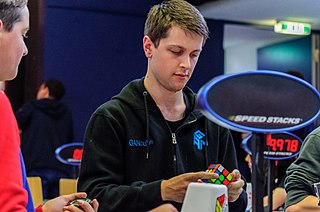
Feliks Aleksanders Zemdegs is an Australian Rubik's Cube speedsolver. He is one of the only two speedcubers ever to win the World Cube Association World Championship twice, winning in 2013 and 2015, and is widely considered the most successful and greatest speedcuber of all time. He has set more than 350 records across various speedcubing events: 121 world records, 211 continental records, and 6 national records.
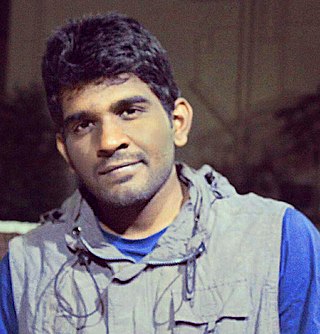
Krishnam Raju Gadiraju is an accomplished Indian speedcuber and unicyclist. He is a six-time world record holder and the first Indian to ever set a world record in speedcubing and unicycling.